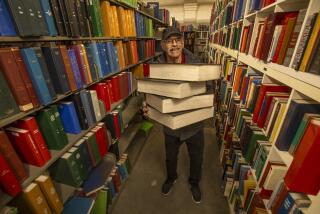A Career That’s Still Unfolding
- Share via
The world’s greatest living expert on pop-up books is Waldo Hunt, 82, of Encino. He is responsible for the renaissance in that low-tech literary art form, which languished in America for 100 years until he revived it in the 1960s. And he is the driving force behind a new exhibit at the Central Library in Los Angeles, which features rare antique originals from his collection and from the department of special collections at the UCLA library.
The exhibit, in two galleries on the first and second floors, is a bit of a tease. It is filled with exquisitely illustrated books whose parts would move if only a visitor could spin the paper wheels, or pull and push the paper tabs and levers. But it is all behind glass, untouchable for obvious reasons. This is not for little children with low frustration levels.
But for those who love the history of books, the great names of the pop-up genre are all here. There are Meggendorfers and Nisters--children’s books created by the two German artists whose work is the hallmark of the late 1800s, considered the Golden Age of pop-ups, when upper-class Europeans lavished their children with expensive playthings.
And books by the Polish master Jan Pienkowski, born in 1936, whose “Haunted House” (published in 1979) has movable bats in its belfry, and is an all-time classic and bestseller. Robert Sabuda, who teaches at the Pratt Institute in New York, is known as the Prince of Paper. His award-winning “The Wonderful Wizard of Oz” is on view with its cyclone that swirls and hot air balloon that dangles over the Emerald City.
The classic Victorian fairy tale books show delicate children at play with movable pastel pets. And scary stories offer vile monsters that rise without warning from flattened pages.
The saga of Hunt’s entry into this esoteric arena is, in a sense, the story of entrepreneurs in America. Hunt was no bibliophile or scholar. He never saw rare books as his potential paycheck or passion. He was an adman at the start, a guy who’d served in World War II and wanted to strike it rich when he came home to California. So he opened an ad agency in Los Angeles (W.H. Hunt & Associates), worked his heart out and made a small fortune when he sold his successful business to an even bigger agency (Compton) in New York.
Hired by Compton as part of the deal, Hunt moved to Manhattan with his family. Somewhere along the way, he said by phone last week from his Marina del Rey offices, the joy of agency life fizzled.
“At one point, my biggest client was Volkswagen. I’d worked doggedly to build up business for them. Once I’d done it, they switched the account to another agency. I knew right then that I needed something that would be all mine, a business that couldn’t disappear on me.”
He started another firm, Graphics International, not knowing exactly for what purpose. Then, while strolling on Fifth Avenue, he saw a beautiful imported children’s pop-up book in a toy store window. Bells went off in his head.
“I knew I’d found the magic key. I would make pop-up insert ads for magazines, pop-up supermarket displays, pop-up promotional pieces and direct-mail campaigns. Being an adman, and quite innovative, I could look at that children’s book from Czechoslovakia and see in it my answer. No one was doing pop-ups in this country. No one could afford to make them here. They had to be done by hand, and labor was too expensive. I knew printers and engineers in Japan, where hand labor was much less expensive then.”
He had struck another gold mine. His entrance into pop-ups was a magazine ad campaign for Wrigley’s gum. “It was a series of 14 ads of zoo scenes; we produced 1 million magazine inserts for each of the 14 ads. It was a major breakthrough in the industry,” Hunt recalled. And business just kept getting better.
He connected with Hallmark and started producing pop-up table decorations and greeting cards for them. At that point, he says, he was the only person in the world doing what he did. He became expert at finding skilled paper engineers and production facilities in countries where labor and artistry were affordable. He began collecting pop-up paraphernalia for his private collection.
Hunt says the term “pop-up” is generally taken to mean movable as well. Modern children’s books involve paper wheels to turn, tabs and levers to push or pull--and the characters often appear to move with or without popping up.
He produced the first movable book for Random House in 1965. “Within two years we had 30 pop-up titles in production for Random House.” They were mostly for children. In the late ‘60s, he sold his company to Hallmark, reaping another handsome profit. Back in Los Angeles in 1973, he formed Intervisual Books, which he said is still the major creator and producer of movable books in the world. He is now chairman emeritus of the company, and its major stockholder.
Hunt is also the proprietor of the Waldo Hunt Children’s Museum, an interactive play place where children can view and learn to create movable books. The museum is closed while it relocates to Marina del Rey, Hunt said. It will reopen in January.
More to Read
Sign up for our Book Club newsletter
Get the latest news, events and more from the Los Angeles Times Book Club, and help us get L.A. reading and talking.
You may occasionally receive promotional content from the Los Angeles Times.










